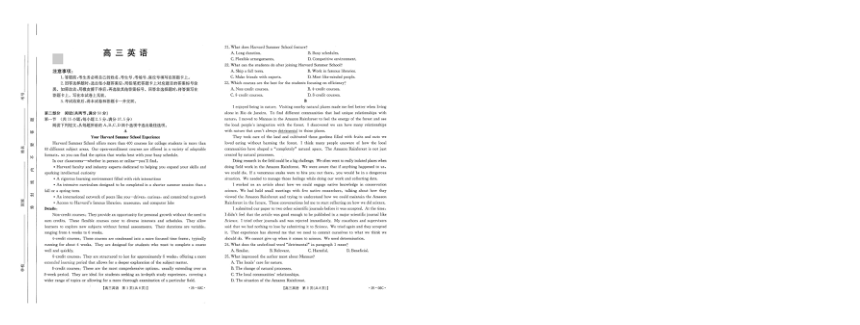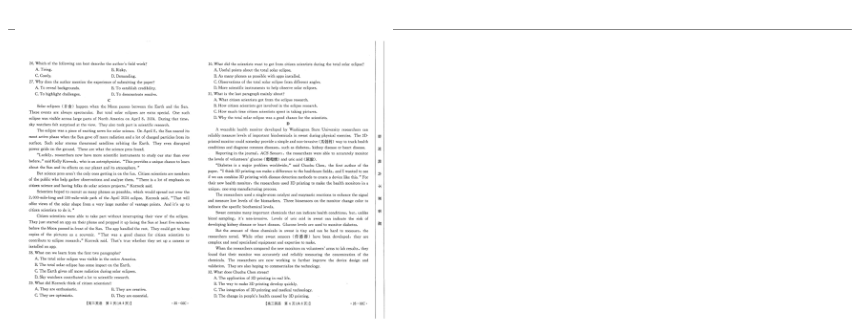广东省部分学校2024-2025学年高三8月开学考试英语试题(图片版,无答案)
文档属性
| 名称 | 广东省部分学校2024-2025学年高三8月开学考试英语试题(图片版,无答案) |  | |
| 格式 | docx | ||
| 文件大小 | 1.9MB | ||
| 资源类型 | 教案 | ||
| 版本资源 | 人教版(2019) | ||
| 科目 | 英语 | ||
| 更新时间 | 2024-08-27 18:48:32 | ||
图片预览


文档简介
26.Which of the following can best describe the author's field work
30.What did the scientists want to get from citizen scientists during the total solar eclipse
A.Tiring.
B.Risky.
A.Useful points about the total solar eclipse.
C.Costly.
D.Demanding.
B.As many phones as possible with apps installed.
27.Why does the author mention the experience of submitting the paper
C.Observations of the total solar eclipse from different angles.
A.To reveal backgrounds.
B.To establish credibility.
D.More scientific instruments to help observe solar eclipses.
C.To highlight challenges.
D.To demonstrate resolve.
31.What is the last paragraph mainly about
A.What citizen scientists got from the eclipse research.
Solar eclipses (happen when the Moon passes between the Earth and the Sun.
B.How citizen scientists got involved in the eclipse research.
These events are always spectacular.But total solar eclipses are extra special.One such
C.How much time citizen scientists spent in taking pictures.
eclipse was visible across large parts of North America on April 8,2024.During that time,
D.Why the total solar eclipse was a good chance for the scientists.
sky watchers felt surprised at the view.They also took part in scientific research.
D
The eclipse was a piece of exciting news for solar science.On April 8,the Sun neared its
A wearable health monitor developed by Washington State University researchers can
most active phase when the Sun gave off more radiation and a lot of charged particles from its
reliably measure levels of important biochemicals in sweat during physical exercise.The 3D-
surface.Such solar storms threatened satellites orbiting the Earth.They even disrupted
printed monitor could someday provide a simple and non-invasive (way to track health
power grids on the ground.These are what the science pros found.
conditions and diagnose common diseases,such as diabetes,kidney disease or heart disease.
学
"Luckily,researchers now have more scientific instruments to study our star than ever
Reporting in the journal,ACS Sensors,the researchers were able to accurately monitor
before,"said Kelly Korreck,who is an astrophysicist."This provides a unique chance to learn
the levels of volunteers'glucose(葡萄糖)and uric acid(尿酸).
about the Sun and its effects on our planet and its atmosphere."
"Diabetes is a major problem worldwide,"said Chuchu Chen,the first author of the
But science pros aren't the only ones getting in on the fun.Citizen scientists are members
paper."I think 3D printing can make a difference to the healthcare fields,and I wanted to see
of the public who help gather observations and analyze them."There is a lot of emphasis on
if we can combine 3D printing with disease detection methods to create a device like this."For
citizen science and having folks do solar science projects,"Korreck said.
their new health monitor,the researchers used 3D printing to make the health monitors in a
unique,one-step manufacturing process.
Scientists hoped to recruit as many phones as possible,which would spread out over the
The researchers used a single-atom catalyst and enzymatic reactions to enhance the signal
2,000-mile-long and 100-mile-wide path of the April 2024 eclipse.Korreck said,"That will
and measure low levels of the biomarkers.Three biosensors on the monitor change color to
offer views of the solar shape from a very large number of vantage points.And it's up to
indicate the specific biochemical levels.
citizen scientists to do it.
Sweat contains many important chemicals that can indicate health conditions,but,unlike
哦
Citizen scientists were able to take part without interrupting their view of the eclipse.
blood sampling,it's non-invasive.Levels of uric acid in sweat can indicate the risk of
They just started an app on their phone and propped it up facing the Sun at least five minutes
developing kidney disease or heart disease.Glucose levels are used to monitor diabetes.
觀
before the Moon passed in front of the Sun.The app handled the rest.They could get to keep
But the amount of these chemicals in sweat is tiny and can be hard to measure,the
copies of the pictures as a souvenir."That was a good chance for citizen scientists to
researchers noted.While other sweat sensors (have been developed,they are
contribute to eclipse research,"Korreck said.That's true whether they set up a camera or
complex and need specialized equipment and expertise to make.
installed an app.
When the researchers compared the new monitors on volunteers'arms to lab results,they
28.What can we learn from the first two paragraphs
found that their monitor was accurately and reliably measuring the concentration of the
A.The total solar eclipse was visible in the entire America.
chemicals.The researchers are now working to further improve the device design and
B.The total solar eclipse has some impact on the Earth.
validation.They are also hoping to commercialize the technology.
C.The Earth gives off more radiation during solar eclipses.
32.What does Chuchu Chen stress
D.Sky watchers contributed a lot to scientific research.
A.The application of 3D printing in real life.
29.What did Korreck think of citizen scientists
B.The way to make 3D printing develop quickly.
A.They are enthusiastic.
B.They are creative
C.The integration of 3D printing and medical technology.
C.They are optimistic.
D.They are essential.
D.The change in people's health caused by 3D printing.
【高三英语第3页(共8页)】
·25-02C·
【高三英语第4页(共8页)】
·25-02C·
30.What did the scientists want to get from citizen scientists during the total solar eclipse
A.Tiring.
B.Risky.
A.Useful points about the total solar eclipse.
C.Costly.
D.Demanding.
B.As many phones as possible with apps installed.
27.Why does the author mention the experience of submitting the paper
C.Observations of the total solar eclipse from different angles.
A.To reveal backgrounds.
B.To establish credibility.
D.More scientific instruments to help observe solar eclipses.
C.To highlight challenges.
D.To demonstrate resolve.
31.What is the last paragraph mainly about
A.What citizen scientists got from the eclipse research.
Solar eclipses (happen when the Moon passes between the Earth and the Sun.
B.How citizen scientists got involved in the eclipse research.
These events are always spectacular.But total solar eclipses are extra special.One such
C.How much time citizen scientists spent in taking pictures.
eclipse was visible across large parts of North America on April 8,2024.During that time,
D.Why the total solar eclipse was a good chance for the scientists.
sky watchers felt surprised at the view.They also took part in scientific research.
D
The eclipse was a piece of exciting news for solar science.On April 8,the Sun neared its
A wearable health monitor developed by Washington State University researchers can
most active phase when the Sun gave off more radiation and a lot of charged particles from its
reliably measure levels of important biochemicals in sweat during physical exercise.The 3D-
surface.Such solar storms threatened satellites orbiting the Earth.They even disrupted
printed monitor could someday provide a simple and non-invasive (way to track health
power grids on the ground.These are what the science pros found.
conditions and diagnose common diseases,such as diabetes,kidney disease or heart disease.
学
"Luckily,researchers now have more scientific instruments to study our star than ever
Reporting in the journal,ACS Sensors,the researchers were able to accurately monitor
before,"said Kelly Korreck,who is an astrophysicist."This provides a unique chance to learn
the levels of volunteers'glucose(葡萄糖)and uric acid(尿酸).
about the Sun and its effects on our planet and its atmosphere."
"Diabetes is a major problem worldwide,"said Chuchu Chen,the first author of the
But science pros aren't the only ones getting in on the fun.Citizen scientists are members
paper."I think 3D printing can make a difference to the healthcare fields,and I wanted to see
of the public who help gather observations and analyze them."There is a lot of emphasis on
if we can combine 3D printing with disease detection methods to create a device like this."For
citizen science and having folks do solar science projects,"Korreck said.
their new health monitor,the researchers used 3D printing to make the health monitors in a
unique,one-step manufacturing process.
Scientists hoped to recruit as many phones as possible,which would spread out over the
The researchers used a single-atom catalyst and enzymatic reactions to enhance the signal
2,000-mile-long and 100-mile-wide path of the April 2024 eclipse.Korreck said,"That will
and measure low levels of the biomarkers.Three biosensors on the monitor change color to
offer views of the solar shape from a very large number of vantage points.And it's up to
indicate the specific biochemical levels.
citizen scientists to do it.
Sweat contains many important chemicals that can indicate health conditions,but,unlike
哦
Citizen scientists were able to take part without interrupting their view of the eclipse.
blood sampling,it's non-invasive.Levels of uric acid in sweat can indicate the risk of
They just started an app on their phone and propped it up facing the Sun at least five minutes
developing kidney disease or heart disease.Glucose levels are used to monitor diabetes.
觀
before the Moon passed in front of the Sun.The app handled the rest.They could get to keep
But the amount of these chemicals in sweat is tiny and can be hard to measure,the
copies of the pictures as a souvenir."That was a good chance for citizen scientists to
researchers noted.While other sweat sensors (have been developed,they are
contribute to eclipse research,"Korreck said.That's true whether they set up a camera or
complex and need specialized equipment and expertise to make.
installed an app.
When the researchers compared the new monitors on volunteers'arms to lab results,they
28.What can we learn from the first two paragraphs
found that their monitor was accurately and reliably measuring the concentration of the
A.The total solar eclipse was visible in the entire America.
chemicals.The researchers are now working to further improve the device design and
B.The total solar eclipse has some impact on the Earth.
validation.They are also hoping to commercialize the technology.
C.The Earth gives off more radiation during solar eclipses.
32.What does Chuchu Chen stress
D.Sky watchers contributed a lot to scientific research.
A.The application of 3D printing in real life.
29.What did Korreck think of citizen scientists
B.The way to make 3D printing develop quickly.
A.They are enthusiastic.
B.They are creative
C.The integration of 3D printing and medical technology.
C.They are optimistic.
D.They are essential.
D.The change in people's health caused by 3D printing.
【高三英语第3页(共8页)】
·25-02C·
【高三英语第4页(共8页)】
·25-02C·
同课章节目录
